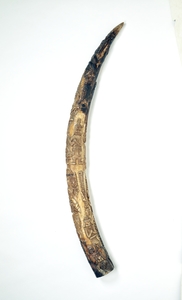| Description |
The ivory carvers were organized in guilds in the kingdom like the metal casters and wood carvers. They worked almost exclusively for the royal court, because ivory was considered royal material. It stood for the court of Oba, but also for the court of Olokun in the otherworld. Moreover, its white color symbolized lime, the sign of peace, wealth and purity. Lime was therefore regularly rubbed on the altars of the god Olokun and also on some of these tusks. In 1897, they stood vertically on the 130 ancestral altars in the courtyards of the royal residence, on mounts or memorial heads. They were covered with the remains of the bloody sacrifices that were regularly offered here. Today, however, the tusk shows the burn marks from the conquest.
The carvings represent: King Ohen (with fish tail, snake belt and ceremonial sword), a warrior (with bell); King Ewuare (supported by two men), King Ohen (dragged by two crocodiles to the realm of the water god Olokun), a messenger from the Kingdom of Ife with two Portuguese. Text: Dietmar Neitzke.The ivory carvers were organized in guilds in the kingdom like the metal casters and wood carvers. They worked almost exclusively for the royal court, because ivory was considered royal material. It stood for the court of Oba, but also for the court of Olokun in the otherworld. Moreover, its white color symbolized lime, the sign of peace, wealth and purity. Lime was therefore regularly rubbed on the altars of the god Olokun and also on some of these tusks. In 1897, they stood vertically on the 130 ancestral altars in the courtyards of the royal residence, on mounts or memorial heads. They were covered with the remains of the bloody sacrifices that were regularly offered here. Today, however, the tusk shows the burn marks from the conquest.
The carvings represent: King Ohen (with fish tail, snake belt and ceremonial sword), a warrior (with bell); King Ewuare (supported by two men), King Ohen (dragged by two crocodiles to the realm of the water god Olokun), a messenger from the Kingdom of Ife with two Portuguese. Text: Dietmar Neitzke. |

